|
TennisOne Lessons Back To the Basics Doug King One of the more ironic things that we come to realize is that as we advance in our development in particular fields the more we come to appreciate and reduce those disciplines to the most basic elements. Often times, it isn’t until we get really good at something that we start to understand, or even care about, the fundamentals. Professional baseball players often study the nuances of their swings off of a batting tee, investigating the nature of a hip turn for example. Pro golfers are obsessed with the infinitesimal nuances of grip, constantly searching for that perfect alignment and touch. Similarly, virtuoso piano players eventually come to realize the significance of good hand position.
The Coordination Principle We generally hear the word “coordination” mentioned in sports context expressed in the phrase “hand-eye coordination.” Hand-eye coordination refers to the act of focusing your eye on an object while performing movements of the body in synchronicity with the object in focus. Tennis is a highly “hand-eye coordination” demanding sport. But what exactly are the implications of this equation? Let’s break it down and see what is revealed. The Eyes First let’s look at focus. In tennis focus can be summed up with the common phrase “keeping your eye on the ball.” To know how to better watch the ball we can start by understanding with what interferes with watching the ball. Movement is one of the things that make it harder to watch the ball. For example, if one tries to read a book, it is much easier to do so by sitting still rather than bouncing on a trampoline. Things that interfere with focus are referred to as distractions. There are many forms of distractions, physical movement which interferes with the physical tracking of the ball with the eyes, mental movement which displaces the mind from its object of focus, and emotional movement which produces a tension that can affect everything. But I think that watching the ball is more than just “seeing” the ball; and that there is more than just the ball that one must see. One must also see the court, the net, the ground, the opponent, and one’s self. And yet we must not so much see them as have “awareness” of them. For “seeing” and “being aware” can be two different things entirely. I can set my eyes on something but be aware of something else. But let’s save that for a little further down the road. For now let’s establish the inherent conflict between watching the ball and moving around.
Take a look around your club at some of the beginning players as they wait for the ball. Much of the time, they stand flat footed. The reason, they are planting so that they can really concentrate on watching the ball. The Hands In tennis we have participants whose only job is to watch the ball. These participants are called linesmen and umpires. We provide chairs, structures of stability that aid their focus on the ball. If a chair is impractical, they must practice moving and locking themselves (hands on knees, feet shoulder width apart) in the most stable base in order to reduce movement and maximize focus on the ball. These individuals are also objective, detached participants who have no stake in the match, no emotional attachment to the outcome. They practice techniques of steadying their minds to maintain their mental focus. Nonetheless, notice how often a bad call occurs at the most critical time of a match – evidence of how emotional instability can effect vision. Coordination and Balance The process of coordinating seeing and moving can start by assigning these functions to specific body parts. Obviously the head and the eyes are the most obvious body parts responsible for seeing. In order to see the ball more clearly it is incumbent upon me to eliminate as much distractive movement as possible from my head to achieve the most efficient tracking technique as possible. Clearly, stability of the head is required to achieve a high degree of ball tracking efficiency.
Moving is more difficult to assign to a specific part of the body as almost everything has to move, but it is typically agreed upon that the feet and legs are the most dynamically active parts of the body, although the arm and hand are also very involved in the moving aspects of the game. So the equation now reads as follows: tennis requires two separate and opposing functions, seeing and moving. Seeing is centered primarily in the upper body especially the head and is dependent upon a quiet, passive state. Movement is centered in the lower body, especially the feet, and it is dependent upon a flexible, active state. Now the question is how do I manage to achieve this? The answer is “balance.” When I am in balance two conditions exist; one is stability and the other is relaxation. Stability allows the upper body to stay steady and the lower body to remain relaxed and active and as long as I stay in balance, I can keep these two things functioning simultaneously in their respective centers. If we break down balance we can identify two components – both represent forms of alignment. There is an “external alignment” to balance which we refer to as posture. We want to align our bodies over our feet to achieve stability and reduce tension. There is also an internal alignment to balance of relaxation which is achieved by breathing (tension cleansing exhales). Imagine these cleansing breaths not only lower the center of gravity but also act as a lubricant to the central axis of the body (the spine) to allow the torso to rotate and shift freely on this axis.
The Base Position and Dynamic Balance
Using the umbrella analogy as a model, we can align our bodies through a good vertical posture and lower our center of gravity by using controlled, “cleansing” exhales. This will put me into a state of good balance which we can refer to as the “Base Position.” From this position the challenge is to increase the amount of activity in the lower body without disrupting the passive, focused state of the head. This is now moving us from a static (planted) balanced position to a dynamic (moving) balanced position.
The same thing occurs when we finalize our steps to the ball. Often times we don’t think we can get to it and we lunge or stretch to the ball. A good mover will trust in his feet and let the feet get to the ball rather than panic and stretch out prematurely. Baseball players make this same mistake when running to first base. Often they will slide head first rather than continuing their stride through the bag.
There is an illusion of ease that typifies this kind of play but it is actually based upon precise alignment of body and breath, reflex and design, moving and non-moving. Adding Patience and Confidence to Your Footwork To develop more balance to your play try these exercises. Stand at the baseline facing the net and establish your Base Position. Start walking forward to the net and backward to the baseline tying to hold your focus on a single point on the facing fence. Walking is actually a perfect, albeit simple, example of coordinated movement (steady head and active feet). Next try to add a swing into the walk (forehand). Finally add a series of tossed balls into the walk and see if you can keep your walk natural, fluid, and uninterrupted as you stroke the balls. Do this moving both forward and backward.
Another form of this exercise is to hold a cup of water in your hands. Hold the water comfortably in front of your midsection, then go through some imaginary footwork patterns mimicking stroking movements. With the cup of water in one hand, take a racquet in the other and then repeat. Finally have someone toss balls to you within easy reach and see if you can keep the water from spilling while you stroke the balls over the net, gradually adding more footwork, bend, and turn into your movement. Summation The essence of tennis comes down to some very basic elements of watching the ball and moving the body. The ability to integrate these two opposing functions is called “coordination” and it is dependent upon balance. Balance has two components, posture and breathing. The goal of balance is to allow the upper body/head to stay passive and quiet and to allow the lower body/feet to remain loose and active. Your comments are welcome. Let us know what you think about Doug King's article by emailing us here at TennisOne.
Doug is one of the country's foremost tennis teaching innovators. Founder of Acceleration Tennis, a revolutionary teaching system, King is leading the way in reinterpreting the traditional tennis model. Doug King is currently Director of Tennis at Meadowood Napa Valley ( www.meadowood.com ), a Relaix Chateau Resort in St. Helena , CA . For more information on Acceleration Tennis please email Doug King at dking@meadowood.com. |

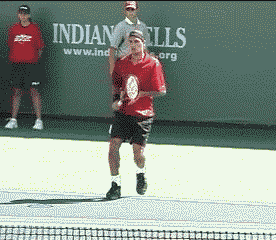
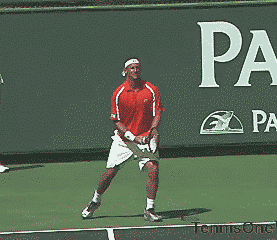
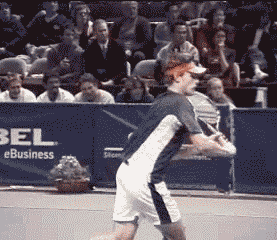
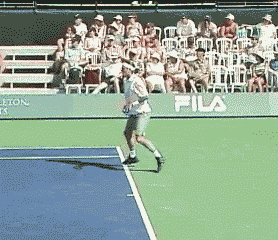
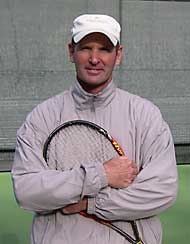
 Doug King studied with legendary tennis coach Tom Stow and was a
former California State Men's Singles Champion
and the former number one men's player of Northern California.
Doug King studied with legendary tennis coach Tom Stow and was a
former California State Men's Singles Champion
and the former number one men's player of Northern California.